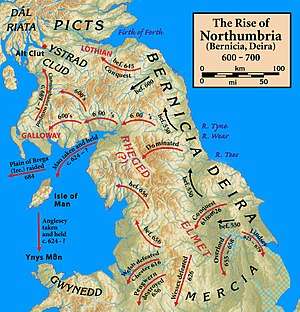Deira
Deira (/ˈdaɪərə/ or /ˈdɛərə/)[1] (Old English: Derenrice or Dere) was an Anglo-Saxon kingdom[2] in Northern England. The kingdom was previously inhabited by Britons and was probably created in the third quarter of the fifth century when Anglian warriors invaded the Derwent Valley.[3] Deira's territory extended from the Humber to the Tees, and from the sea to the western edge of the Vale of York. It later merged with the kingdom of Bernicia, its northern neighbour, to form the kingdom of Northumbria.
Kingdom of Deira | |||||||||
|---|---|---|---|---|---|---|---|---|---|
| c. 450–654 | |||||||||
| Capital | York | ||||||||
| Common languages | Old English, Common Brittonic | ||||||||
| Government | Monarchy | ||||||||
| Historical era | Early Medieval | ||||||||
• Established | c. 450 | ||||||||
• Shared crown with Bernicia | 604 | ||||||||
• merged with Bernicia | 654 | ||||||||
| |||||||||

The name of the kingdom is of Brythonic origin from the Proto-Celtic *daru, meaning "oak", (derw in modern Welsh) in which case it would mean "the people of the Derwent", a derivation also found in the Latin name for Malton, Derventio.[4] It is cognate with the modern Irish doire (pronounced [ˈd̪ˠɛɾˠə]); The origin of the name for County Londonderry and city of Derry stems from this word.[5][6]
According to Simeon of Durham (writing early in the 12th century), it extended from the Humber to the Tyne, but the land was waste north of the Tees. After the Brythonic kingdom centred on Eboracum, which may have been called Ebrauc, was taken by King Edwin, the city of Eboracum became its capital, and Eoforwic ("boar-place") was taken by the Angles.[7]
Archaeology suggests that the Deiran royal house was in place by the middle of the fifth century, but the first certainly recorded king is Ælla in the late sixth century.[8] After his death, Deira was subject to king Æthelfrith of Bernicia, who united the two kingdoms into Northumbria. Æthelfrith ruled until the accession of Ælla's son Edwin, in 616 or 617, who also ruled both kingdoms until 633.[9]
Osric, the nephew of Edwin, ruled Deira after Edwin, but his son Oswine was put to death by Oswiu in 651. For a few years subsequently, Deira was governed by Æthelwald son of Oswald of Bernicia.[10]
Bede wrote of Deira in his Historia Ecclesiastica (completed in 731).[11]
Kings of Deira
| Reign | Incumbent | Notes | |
|---|---|---|---|
| 559/560 to 589 | Ælla (Aelli) |
ÆLLA YFFING DEIRA CYNING ÆLLA REX DEIRA |
|
| 589/599 to 604 | Æthelric (Aedilric) |
ÆÞELRIC IDING BERNICIA 7 DEIRA CYNING ÆÞELRIC REX BERNICIA ET DEIRA |
|
| Bernicia Dynasty | |||
| 593/604? to 616 | Æthelfrith | ÆÞELFERÞ ÆÞELRICING DEIRA CYNING ÆÞELFERÞ REX DEIRA |
Killed in battle |
| Deira Dynasty | |||
| 616 to 12/14 October 632 | Edwin | EDVVIN ÆLLING BERNICIA 7 DEIRA CYNING EDVVIN REX BERNICIA ET DEIRA |
Killed in battle by Cadwallon of Gwynedd and Penda of Mercia |
| late 633 to summer 634 | Osric | OSRIC ÆLFRICING DEIRA CYNING OSRIC REX DEIRA |
|
| Bernicia Dynasty | |||
| 633 to 5 August 642 | Oswald | OSVVALD BERNICIA 7 DEIRA CYNING OSVVALD REX BERNICIA ET DEIRA |
Killed by Penda, King of Mercia; Saint Oswald |
| 642 to 644 | Oswiu | OSVVIO ÆÞELFRIÞING BERNICIA 7 DEIRA CYNING OSVVIO REX BERNICIA ET DEIRA |
|
| Deira Dynasty | |||
| 644 to 651 | Oswine | OSVVINE OSRICING DEIRA CYNING OSVVINE REX DEIRA |
Murdered |
| Bernicia Dynasty | |||
| summer 651 to late 654 or 655 | Æthelwold | ÆÞELVVALD OSVVALDING DEIRA CYNING ÆÞELVVALD REX DEIRA |
|
| 654 to 15 August 670 | Oswiu | OSVVIO ÆÞELFERÞING NORÞANHYMBRA CYNING OSVVIO REX NORÞANHYMBRA |
Restored |
| 656 to 664 | Alchfrith | ALCHFRIÞ DEIRA CYNING ALCHFRIÞ REX DEIRA |
|
| 670 to 679 | Aelfwine | ÆLFVVINE DEIRA CYNING ÆLFVVINE REX DEIRA |
|
Notes
- A Complete Pronouncing Gazetteer, Or, Geographical Dictionary of the World, 1880
- McCarthy, Mike. "An Early Historic Celtic Kingdom near the Solway". 2014. The History Files. Retrieved 18 May 2014.
- Higham, p. 98
- Higham, p. 81
- Library Ireland Archived 8 February 2012 at the Wayback Machine – Sketches of Olden Days in Northern Ireland
- Anthony David Mills (6 November 2003). A Dictionary of British Place-Names. Oxford University Press. pp. 430–. ISBN 978-0-19-852758-9. Archived from the original on 18 June 2013. Retrieved 27 June 2012.
- Malam, John (2011). "Yorkshire, A Very Peculiar History". Book House. ISBN 978-1907184574.
- Higham, pp. 77-78
- Garmonsway, G. N. (1954). The Anglo-Saxon Chronicle. London: Dent. pp. 26–27. ISBN 0460106244.
- D. P. Kirby, The Earliest English Kings (1991, 2000), page 78.
- Bede, Historia Ecclesiastica, III, 14
References
- Higham, N.J. (1993). The Kingdom of Northumbria AD 350–1100. Stroud: Sutton. ISBN 0-86299-730-5
- Mackenzie, E.; Ross, M. (1834), An Historical, Topographical, and Descriptive View of the County Palatine of Durham, I, Newcastle upon Tyne: Mackenzie and Dent, p. xi, retrieved 2008-07-23
Further reading
- Geake, Helen & Kenny, Jonathan (eds.) (2000). Early Deira: Archaeological studies of the East Riding in the fourth to ninth centuries AD. Oxford: Oxbow. ISBN 1-900188-90-2